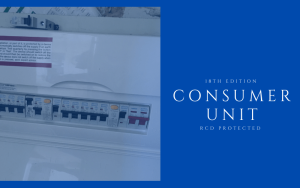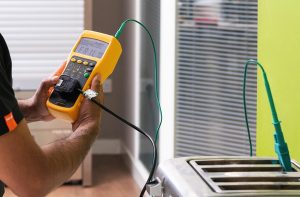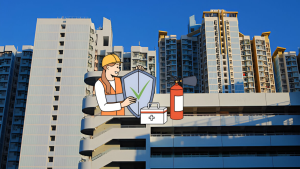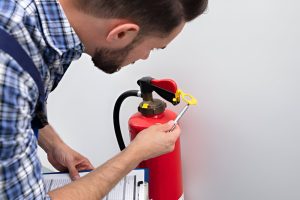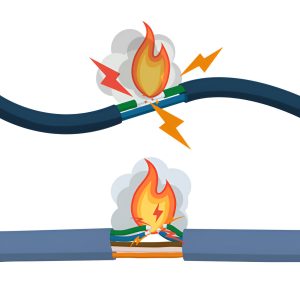PAT testing is an essential part of ensuring a rental property’s electrical safety. Not only does it protect the landlord, but it also protects tenants from potential fire hazards and other dangers associated with defective equipment.
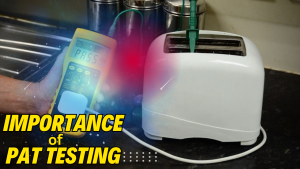
As a PAT testing expert, I’m here to explain what PAT testing is and why it’s so important for rental properties.
PAT stands for ‘Portable Appliance Testing’ – it’s the process of inspecting portable appliances in order to make sure they are safe for use and meet current standards of health and safety regulations.
This involves checking the plug, cord and casing for any signs of wear or damage that could indicate unsafe operation. It also includes running tests on the appliance itself, such as Continuity Tests, Flash Tests or Earth Bonding Tests.
The results must then be documented in accordance with relevant legislation. In short: PAT testing is about making sure all electrical items used in rental properties are safe for both landlords and tenants alike!
What Is Pat Testing?
PAT Testing is an essential part of risk mitigation and data protection. It examines electrical appliances to ensure they are safe for use in any environment, especially rental properties.
PAT Testing consists of a series of checks and tests that measure the safety of electrical equipment such as fridges and washing machines. This rigorous process ensures that all potential risks from using faulty or damaged appliances can be identified before any harm comes to people who may come into contact with them.
The inspection will involve looking at the plugs, cables, sockets, fuses, switches and other components related to the appliance being tested. The tester will also look for signs of wear and tear on these parts which could lead to fire hazards or electric shocks if not addressed quickly.
If any faults are found during this assessment then further action must be taken to correct it immediately in order to keep everyone safe. To guarantee safety within rental properties, PAT Testing should be conducted regularly by qualified professionals who know exactly what needs to be done.
Keeping up with regular testing helps landlords protect their tenants while ensuring that they remain compliant with important regulations designed to safeguard public health and safety.
The Testing Process
Having established what PAT testing is and why it’s important for rental properties, the next step is examining the process itself.
PAT testing involves comprehensive visual inspections to determine whether electrical appliances are in a safe condition for use. This entails checking plugs, sockets, cables and leads, as well as all types of switches such as isolators. The tests aim to detect any signs of damage or wear that could cause electric shock or fire hazards should the appliance be used by tenants.
The qualified engineers carrying out these tests will also check if an item has been made with quality materials suitable for its purpose and properly labelled with manufacturer’s details. Furthermore they’ll examine the voltage rating, current draw and earthing arrangements to ensure safety standards have been met both during manufacture and installation processes.
Portable Appliance Testing allows us to uncover any potential risks associated with everyday items before they can impact people’s lives.
The results from these detailed assessments are then logged into reports which help landlords understand their responsibilities regarding tenant safety and highlight areas where maintenance may be necessary. Ultimately, this helps them meet their legal obligations when renting out property while ensuring peace of mind for all involved parties.
Equipment Safety Regulations
Pat testing is a critical step for rental property owners and managers to ensure their equipment meets safety regulations. It involves testing the electrical appliances in your home and making sure they are up to code, free of hazards, and energy efficient. When pat testing is done correctly it can help protect both tenants and landlords from potential damage or injury caused by improper appliance maintenance.
Here’s an overview of what you need to know about pat testing:
- Pat Testing ensures that all electrical appliances comply with current regulations such as BS7671 (the 17th Edition Wiring Regulations). This includes checking plugs and cords for any signs of wear and tear, ensuring adequate insulation, and inspecting each item for its rating label so that it can be used safely.
- Pat Testing assesses the condition of the appliance itself including connections, switches, leads and general build quality which could affect how safe it is to use. A good pat test should also check for energy efficiency standards too, helping landlords save money on electricity bills over time.
- Lastly, regular pat tests will provide proof that due diligence has been taken when carrying out appliance maintenance at a rental property – giving extra peace of mind to landlords who may face legal action if something goes wrong with their tenant’s possessions.
In summary then; proper pat testing is essential for any landlord looking to keep their properties compliant with safety regulations whilst maximising energy efficiency savings in the long run.
Continuity Tests
Continuity tests are a vital part of PAT testing for rental properties. It is important to ensure that all electrical items used within the property – from kitchen appliances to lighting fixtures – are not prone to short circuits and other potential hazards.
Continuity tests involve checking that any exposed metal parts, such as plugs or sockets, do not pose risks of electric shock or fire by conducting an electrical current through them. This is done using specialised equipment which measures resistance between different points on the appliance being tested.
In addition to continuity tests, flame tests can be conducted in order to detect whether a particular item poses a risk of fire due to insulation breakdowns or faulty wiring connections. The test involves measuring how fast electricity travels along certain elements within the device and comparing it with expected values obtained from manufacturers’ specifications. If they differ significantly then there may be a problem requiring further investigation.
Similarly, insulation tests aim at verifying that an appliance does not have defective insulation around its cables or wires which could cause electric shocks if touched directly with bare hands.
By ensuring these safety checks are performed regularly, landlords can guarantee their tenants’ safety against any potential electrical hazards when inhabiting their rental property. Furthermore, this will also reduce financial losses caused by fires, damages and insurance claims due to negligence in carrying out adequate inspections beforehand.
Overall, PAT testing is invaluable for protecting both parties involved in rental contracts from potentially devastating outcomes associated with unsafe electrical devices.
Flash Tests
Flash testing, also known as pat testing, is an important part of rental properties.
Visual inspections are key to ensure all electrical items are safe to use.
Insulation resistance testing is also important to make sure electrical equipment is in good condition.
Earth bond testing is essential to ensure that the electrical items are properly earthed.
All of these tests are needed to ensure that rental properties are safe and compliant with current regulations.
Without them, the risks of electrical shock and fire are much higher.
That’s why it’s so important to make sure that flash testing is done regularly.
Visual Inspections
Visual inspections are one of the most important aspects of any pat testing. A thorough visual inspection is conducted to ensure all components and connections are in good condition, with no sign of visible damage or deterioration. This includes checking for signs of wear and tear, defective insulation, improper routing and more – anything that could cause potential hazards should be identified and addressed before further testing can take place. All pat testers must adhere to rigorous standards set out by their governing body when conducting a visual inspection on an electrical system.
Flash tests enable us to detect faults which may not be visually apparent but still pose a safety risk. Through this method we use applied voltage which causes current flow through the component being tested; if there’s an issue present then it will be detected at this stage due to increased resistance or other anomalies. As such flash tests provide an important link between visual inspections and continuity/resistance tests as they’re able to identify problems that would otherwise go undetected.
By combining these detection methods with effective record keeping, we can guarantee rental properties meet necessary safety requirements without compromising on quality assurance. Pat Testing is essential for ensuring rental properties remain safe from electrical hazards so tenants have peace-of-mind when moving into new accommodation.
Insulation Resistance Testing
Next, we come to insulation resistance testing. This is an important part of any pat testing regime as it allows us to detect power surges and overloaded circuits.
Insulation resistance tests measure the level of electrical leakage current within a system – if there are faults present then these will be identified through an increase in the measured values. It’s also a very useful tool for identifying damaged cabling which can lead to serious hazards if left undetected. This test should always be conducted alongside flash tests and visual inspections for optimal safety assurance.
The measuring process itself is fairly straightforward: using low voltage on one side of the circuit and high voltage on the other; this creates what’s known as an ‘isolation barrier’ between these two points – when combined with our equipment, we’re able to accurately measure levels of insulation resistance from both sides and determine whether or not there are any potential problems. As such it’s essential that all pat testers have access to reliable, up-to-date equipment when conducting insulation resistance tests.
It’s also worth noting that each appliance has its own individual set of instructions regarding how often they need to be tested; some may require monthly checks while others may only need annual ones – whatever the case may be, it’s crucial that you adhere strictly to manufacturer guidelines otherwise you could endanger your tenants’ wellbeing!
Earth Bond Testing
Once you’ve completed your insulation resistance tests, it’s time for earth bond testing. This is an essential part of any pat testing regime as it helps to ensure that all electrical appliances are safely earthed; meaning they won’t cause a shock hazard if touched or otherwise interacted with.
Earth bond tests use special equipment which measures the current flow between two points – if there’s no current then we know the appliance is safe and can be used without worry. It’s important to remember that this test should always be conducted alongside flash tests and visual inspections in order to maintain optimal safety standards.
We also recommend checking manufacturer guidelines regarding how often each appliance needs to be tested – some may require monthly checks while others might only need annual ones! Appliance safety is paramount so make sure you’re aware of these rules before using any new products.
Taking the extra steps necessary will go a long way towards guaranteeing complete electrical safety for everyone involved.
Overall, earth bond testing plays a vital role in ensuring compliance with industry regulations and keeping people from harm – so don’t forget to check those connections every now and again!
Earth Bonding Tests
Pat testing is a vital part of ensuring the safety and functionality of any rental property.
One important aspect of pat testing is Earth Bonding tests, which are designed to ensure that electrical items in the home are safe for users.
Earth Bonding tests measure how well earth leakage protection devices function by measuring whether there is an electric current between our socket outlets and earth points. This helps us to prevent risks such as electrocution, fire hazards, and even accidental shock from happening.
It also ensures that sockets remain correctly earthed – this increases their safety by keeping them protected against surges or other problems caused by nearby electrical faults.
We can use various tools such as clamps, probes and insulation testers to accurately measure the voltage levels in each socket outlet during Earth Bonding tests. Through these tests we can make sure that everything is up-to-date with regards to Socket Safety regulations, thus providing maximum security to both tenants and landlords alike!
Documenting Test Results
I’m a pat testing expert, and I’m here to explain why it’s so important for rental properties to document test results.
Recording equipment details helps to ensure that all test results are accurate and up-to-date.
Creating test reports provides a detailed overview of any electrical safety hazards that need to be addressed.
And maintaining records of all tests can help to demonstrate that a landlord is meeting their legal obligations.
It’s essential that pat testing is carried out regularly in rental properties, as it helps to protect tenants from the risks of electrical hazards.
Ultimately, documenting test results is vital for rental properties to remain safe and compliant.
Recording Equipment Details
As a pat testing expert, recording equipment details is an essential part of documenting test results.
I always start by creating an inventory to include the serial number and model of each item being tested. This provides me with all the information needed for preventive maintenance in order to identify any areas that may require further inspection according to safety guidelines.
Furthermore, this allows rental property owners to monitor the condition of their assets over time which helps them decide if they should replace or repair specific items before any issues arise.
Keeping detailed records also makes it easier for landlords to keep track of compliance and provide evidence when necessary.
All in all, taking extra care to document equipment details ensures rental properties are safe and up-to-date with current inspections standards.
Creating Test Reports
Once I have created an inventory and documented equipment details, the next step is to create a test report.
This involves conducting a risk assessment of all items tested in order to identify any potential hazards that could lead to accidents or damage.
After identifying risks, I will then provide recommendations for corrective action if necessary.
Creating accurate and detailed reports is essential for landlords as it serves as evidence of maintenance work carried out on rental properties and helps them comply with health and safety regulations.
Additionally, this also allows property owners to ensure their tenants are living in safe environments which can help prevent costly repairs due to neglect or improper care.
Overall, creating test reports provides pat testing experts with the opportunity to contribute towards providing safer living conditions while ensuring landlords remain compliant with inspection standards.
Maintaining Records
Once I have completed the test report, it is important to maintain records of all tests. This helps landlords stay up-to-date with their legal requirements and keep track of inspection intervals. It’s also a great way for me as an expert pat tester to ensure that my clients are always in compliance with safety standards.
Maintaining accurate records also allows for easy access when conducting future inspections or repairs if necessary. In addition, this gives property owners peace of mind knowing that they can easily prove their compliance with regulations should any issues arise from tenants or other third parties.
All in all, keeping detailed records of tests will help protect both landlords and testers alike while ensuring everyone remains safe and compliant.
Protecting Landlords
Having discussed the importance of documenting test results, it’s now time to explore how pat testing helps protect landlords.
As a landlord, you are obligated by law to ensure that all rental properties you own are safe and meet current safety standards. That’s why having a regular pat testing regime is essential in protecting yourself from potential liability claims.
Pat testing not only ensures that electrical equipment is safe for use but also provides valuable evidence should an issue arise with any tenant living in your property.
Having documented proof of regular inspections can help provide peace of mind when signing lease agreements with tenants and give assurance that their safety is being taken seriously.
Ultimately, as a landlord, you want to make sure that anyone renting one of your properties has a safe environment they can call home.
Pat testing gives you the means to do just this; providing protection against legal repercussions while ensuring both yours and your tenant’s wellbeing remains intact.
Protecting Tenants
As a pat testing expert, I’m here to talk about the importance of pat testing in rental properties.
It’s essential for landlords to understand their responsibilities in order to protect the rights of their tenants.
That includes ensuring that all electrical appliances in the property are safe for use.
Pat testing is a great way to do this, as it checks the safety of items like computers, TVs and other electrical equipment.
Tenant Rights
The safety of rental properties is a responsibility that tenants and landlords must share. As a tenant, it’s essential to understand your obligations when it comes to pat testing in order to protect both yourself and the property you’re renting.
Pat testing stands for Portable Appliance Testing and involves checking the electrical appliances within a property against certain standards set by government regulations. This process helps to ensure that all of the devices are functioning safely and correctly, reducing any chances of potential hazards such as electric shocks or fires breaking out due to faulty wiring or equipment misuse.
It also allows landlords to demonstrate their commitment to tenant safety and liability by ensuring their property has been thoroughly inspected before being leased out. Tenants should familiarise themselves with what exactly is involved in pat testing so they understand their rights and responsibilities when it comes time for moving into a new rental space.
Understanding how these tests work will help them stay informed about any risks associated with their living environment, allowing them to make well-informed decisions on whether or not they feel comfortable occupying a particular premises. With this knowledge at hand, tenants can rest assured knowing they have taken proactive steps towards protecting themselves from unnecessary harm while still respecting tenant obligations.
Landlord Responsibilities
When it comes to protecting tenants from potential hazards in rental properties, landlords have a responsibility to ensure their property is regularly maintained and kept up to date with regards to pat testing.
As such, the onus lies on them to perform regular inspections of all electrical appliances within the house or flat. This can range from checking for frayed wiring that could cause electric shocks, to making sure plugs are functioning correctly and not overloading sockets with too many devices at once.
Landlords should also be aware of any tenant security measures they need to put into place; this could include providing fire alarms and smoke detectors as well as ensuring adequate lighting throughout the premises.
By taking these steps, they demonstrate their commitment towards tenant safety while complying with government regulations regarding electrical appliance standards.
Tenants will then feel secure knowing their living environment has been thoroughly inspected before being used.
The Need For Regular Testing
Pat testing, also known as ‘Portable Appliance Testing’, is an essential part of ensuring safety in rental properties. It involves conducting regular tests on electrical appliances to identify any potential electrical hazards that could be hazardous for tenants and visitors.
The need for regular pat testing cannot be overstated; it is absolutely necessary for every rental property owner/manager to ensure their premises are safe from the risk of electric shock or fire caused by faulty equipment. Pat testing helps identify any faults which may have occurred due to age or damage so they can be rectified before someone gets injured or a serious accident occurs.
Regular pat testing ensures that the landlord meets relevant industry standards and provides peace of mind knowing that all risks have been minimised and everyone who uses the property is kept safe.
This is why it’s important to hire a trained professional to conduct these tests with appropriate frequency – typically annually, but more often if there are high-risk appliances present onsite such as refrigerators, washing machines, kettles etc.. Without proper inspection and maintenance, you put your tenants at great risk!
Frequently Asked Questions
How Often Should Pat Testing Be Done?
As an expert in PAT testing, I can tell you that carrying out regular preventative maintenance to test the safety of electrical appliances is absolutely essential.
The frequency with which this should be done depends on how often these items are used; for instance, if your rental property experiences frequent turnover then it’s important to carry out tests as frequently as possible – ideally at least every 3 months or even sooner – in order to keep tenants safe and ensure their peace of mind.
To sum up, when it comes to PAT testing, there’s no such thing as ‘too often’!
What Type Of Qualifications Do Pat Testers Need?
As a pat testing expert, I’m often asked about the qualifications and certifications required of those who perform this important safety procedure.
The requirements vary depending on location and type of equipment being tested, but generally speaking it’s necessary to have certification in electrical safety standards and training specifically related to PAT Testing.
It is also essential for any pat tester to be familiar with applicable government regulations that may apply.
In short, if you’re looking for someone qualified to complete your property’s PAT test make sure they have the right credentials!
Are There Any Exemptions To Pat Testing?
Pat testing is an important part of electrical safety and appliance maintenance, but there may be some exemptions depending on the type of property.
For instance, in a domestic rental property it’s not necessary to pat test items that are classed as low-risk, such as TVs or lamps.
Similarly, if you’re renting out commercial premises for short periods then the tenants may not need to have their own appliances tested either.
It pays to check with your local authority before assuming anything though – they’ll help you make sure all relevant regulations are followed.
What Are The Costs Associated With Pat Testing?
Pat testing is essential for rental properties, and can help save you money in the long run.
The costs associated with pat testing vary depending on the size of your property and the complexity of its electrical systems.
On average, you should expect to pay around £100-£200 per hour plus any materials or equipment used.
Cost savings come from avoiding expensive safety risks that could occur if a fault were missed.
By taking advantage of pat testing services, landlords can rest assured that their rented property is compliant with all relevant regulations – ultimately helping them save time, money, and potential headaches!
Is Pat Testing Mandatory In Rental Properties?
When it comes to rental properties, is pat testing mandatory?
There are pros and cons to consider. On the one hand, safety risks can be reduced with regular pat testing of electrical appliances in the property, so it’s worth looking into for landlords who want to ensure their tenants’ well-being. On the other hand, there may be additional costs involved that need to be factored into a landlord’s budget.
As an expert in PAT Testing, I highly encourage any prospective or current landlord to do their research on local laws and regulations as they pertain to this important issue.
Conclusion
It is clear that PAT testing plays an important role in providing a safe environment for tenants. As such, it should be carried out on a regular basis and by qualified professionals to ensure the safety of everyone living or working in rental properties.
By regularly carrying out PAT testing, landlords can protect their investments and provide peace of mind for both themselves and their tenants.
The associated costs may seem prohibitive at first, but the long-term benefits far outweigh them – especially if there are any incidents which could have been avoided with proper PAT testing protocols in place.



